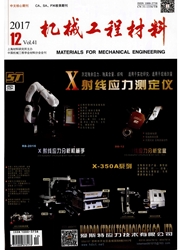

 中文摘要:
中文摘要:
为了学习车轮 / 栏杆滚动,联系高速度的火车的疲劳,我们由介绍紧张率效果获得在车轮和栏杆之间的接触力量的分发。基于有限元素模拟,一个二维的有限元素模型被建立,并且在一个裂缝上滚动的一个车轮的过程被分析预言裂缝繁殖方向。可能的裂缝繁殖角度的统计被最大的环绕的压力标准计算。裂缝路径然后被根据 Weibull 分发把平均裂缝繁殖角度用作裂缝繁殖方向获得。结果证明低速度的火车的栏杆裂缝模式与高速度的火车的不同。栏杆裂缝繁殖从打开模式到在低速度的火车下面滑动模式经历迁居;然而,栏杆裂缝主要在高速度的火车下面在开的模式宣传。而且,为高速度的火车的裂缝繁殖率为低速度的火车是比那快的。模仿的裂缝路径与试验性的一致,它证明把可能的裂缝繁殖方向的平均价值用作实际裂缝繁殖方向是合理的。
 英文摘要:
英文摘要:
To study the wheel/rail rolling contact fatigue of high-speed trains, we obtain the distribution of contact forces between wheel and rail by introducing the strain-rate effect. Based on the finite element simulation, a two-dimensional finite element model is established, and the process of a wheel rolling over a crack is analyzed to predict the crack propagation direction. The statistics of possible crack prop- agation angles are calculated by the maximum circumfer- ential stress criterion. The crack path is then obtained by using the average crack propagation angle as the crack propagation direction according to Weibull distribution. Results show that the rail crack mode of low-speed trains is different from that of high-speed trains. The rail crack propagation experiences a migration from opening mode to sliding mode under the low-speed trains; however, the rail crack mainly propagates in the opening mode under high- speed trains. Furthermore, the crack propagation rate for high-speed trains is faster than that for low-speed trains. The simulated crack paths are consistent with the experimental ones, which proves that it is reasonable to use the average value of possible crack propagation directions as the actual crack propagation direction.
 同期刊论文项目
同期刊论文项目
 同项目期刊论文
同项目期刊论文
 期刊信息
期刊信息
